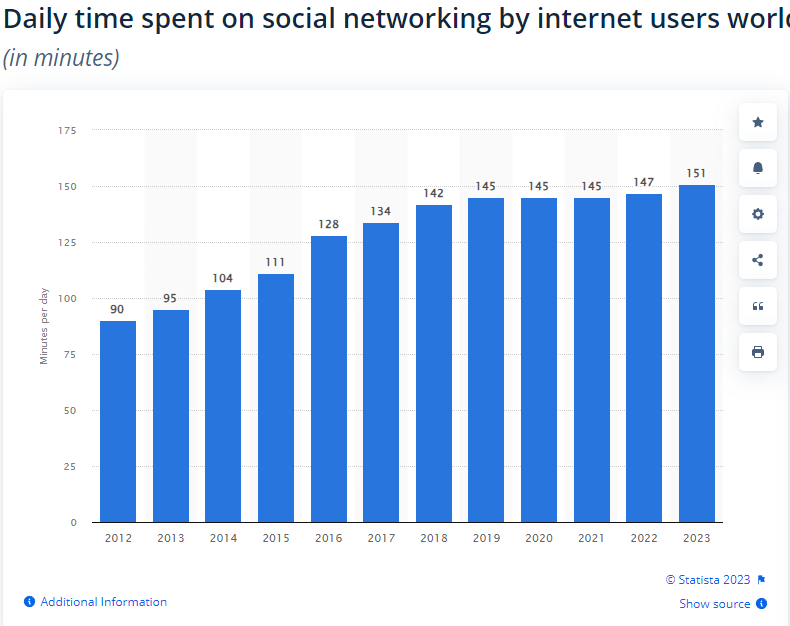The time adults spend on social media is increasing rapidly. Statista’s 2023 data shows adults worldwide spend 151 minutes on social media daily. Marketing challenges arise as people often spend more time on social media than on other types of media.

For many social media users, it is the primary source of news and local information and the top way to stay connected with family and friends. Given people’s significant attention to social media, it’s no surprise that big companies use it for growth. However, using social media effectively is not as simple as logging in and posting content – businesses face several marketing challenges.
What difficulties do businesses encounter on social media, and how can they overcome them? Examining common social media problems like low engagement content creation and measuring ROI is crucial for developing effective strategies to tackle these challenges head-on.
Should Your Business Consider Social Media Marketing?

Social media is where the people are. And they’re spending more time there every year. Platforms purposefully design features to grab your attention and keep it. The more time users spend scrolling and watching, the more ads they see and the more money the platforms make.
Knowing social media dominates people’s attention, it makes sense for small businesses to leverage it for marketing. The marketing challenges are reducing noise and connecting authentically with customers.
The numbers speak for themselves:
- Social media drives over 50% of revenue across many industries.
- Companies using social media meet revenue goals more than those without it.
- Social media boosts conversions.
- It reaches larger audiences at lower costs than other marketing.
- It can accommodate almost any campaign or promotion.
- It drives website traffic.
- It provides customer insights.
- It builds brand awareness.
The list goes on. For small businesses today, engaging on social platforms is practically a necessity. The users are there, and social media offers versatile, cost-efficient marketing opportunities.
Businesses can drive real results by meeting customers where they already spend time. The power of society is hard to ignore.
7 Challenges Encountered in Social Media Marketing
1. The Social Media Platform Dilemma
With new apps constantly emerging, brands face a tough challenge – determining where to invest limited time and resources for social media marketing. With so many options, how do you choose the right platforms to connect with your audience and support your goals? This question stumps many marketers. Choosing the best platforms is a key marketing challenge brands must overcome to succeed with social media.
The Solution: Start with Your Audience
The key is to begin by deeply understanding who your target audience is. Research to identify their platforms rather than making assumptions. Listen to where your audience is already conversing, sharing, and engaging.
Next, analyze what content resonates most with them – video, photos, or live streams. This signals which platforms may be best aligned. Finally, clarify your marketing goals. Do you aim to boost brand awareness? Drive sales? Increase engagement? Different objectives may require different platforms.
While new shiny networks are tempting, avoid scattershot efforts. Truly know your audience, their preferences, and your goals. This understanding will guide you to the best social platforms for real relationship building. Start there, not with the hype.
Moreover, Partnering with an influencer marketing agency in India can provide valuable insights into your target audience and which platforms will best resonate with them.
2. Following the Latest Social Trends

These days, social media trends come and go faster than ever. While great for consumers, this challenges marketers trying to connect with audiences. According to recent research, almost half of marketers struggle to identify and respond to emerging social trends. It’s like finding a needle in an endless haystack.
Manually reviewing endless streams of content to spot relevant trends is extremely difficult. This causes frustration and wasted time for many marketing teams. Thankfully, there are solutions. Social media management tools can automatically surface top trends and topics through AI. This removes manual work.
Other helpful tactics include setting Google Alerts on key industry terms, monitoring hashtag volumes, and tracking influencer content. The pace of social media will only accelerate. But with the right tools and processes, brands can stay on top of trends more efficiently. This allows for content that resonates without getting overwhelmed.
The key is blending smart technology with human insight to separate signal from noise. With the proper approach, social media teams can adopt an agile mindset to successfully ride each new trend wave.
3. Measuring the ROI of Social Media
Social media is indispensable in business strategies, yet some leaders don’t fully recognize its value. The metrics can be hard to quantify. Building a business case for social media is a common marketing challenge. Convincing leadership of the value of social media and securing budget allocation is key to fully leveraging social platforms.
The key is tying social efforts directly to business goals, performance, and the bottom line. Use data to showcase how social media reaches and nurtures customers. Provide real examples of leads and sales generated from social campaigns. Illustrate the concrete ROI. Also, highlights potential risks of not having an effective social media presence.
Speaking the language of business and data is crucial. Demonstrate how social media tangibly connects to achieving targets and objectives. Make this case. With the right approach focused on business impact, social media’s value can be conveyed. Patient relationship-building with leadership is also key. The importance of social can be understood through strategic communication.
4. Creating Content That Keeps People Engaged
Coming up with engaging new content is a common challenge for social media managers. Creative ruts can disrupt posting schedules and social growth. Growing an audience requires consistent, ongoing content.
No matter a campaign’s performance, the next idea must always be ready. This continual need for fresh concepts can feel frustrating. Developing creative content on social media channels is one of the key challenges of service marketing in the digital age.
However, some proactive strategies can help:
- Use social listening tools to uncover trending topics and conversations that resonate with your audience. Join those discussions.
- Stay ahead of emerging trends through an intentional trendspotting strategy. Ride new waves early.
- Collaborate with successful creators or advocates in your space. Analyze what engages their audience and potential partnerships.
- Build in time for real-world inspiration away from social platforms. New perspectives refresh creativity.
- Directly survey your audience on the type of content they want to see. Let them guide your ideas.
- Don’t become overly focused on competitors. Try new concepts aligned with your unique brand voice.
With the right mix of data-driven and human approaches, fresh content ideas can be produced consistently. Creativity takes work, but success is achievable with some strategic thinking.
5. Wasting Time Due to Managing Several Social Channels

Maintaining an active presence on social networks poses marketing challenges for many marketing teams. Juggling content, engagement, and monitoring across multiple profiles and interfaces can feel overwhelming. With limited time in a day, it’s crucial to allocate resources wisely without compromising community relationships or internal workflows.
Some solutions to consider:
- Identify one priority platform based on engagement levels, growth metrics, and business goals. Focus efforts mainly on the core channel.
- Use social media management tools to consolidate profiles into a single dashboard. This streamlines workflows and reduces toggling between networks.
- Distribute responsibilities for specific platforms/tasks across the marketing team. Divide and conquer through delegation.
- Schedule content in aligned batches across channels versus in silos. Plan holistically.
- Structure time for focused community interaction, creation, and analytics. Organization prevents reactive scrambling.
With the right processes, tools, and team structures, managing multiple platforms can become more organized and effective. Focus efforts where they drive the most value with your audience.
6. Standing Out as a Brand on Social Media in a Competitive Space
For emerging brands trying to compete against dominant, well-known players in their industry, gaining traction on social media can seem extremely daunting. When an industry is flooded with big-name brands with huge budgets and massive followings,
It’s easy for a smaller brand to get lost in the shuffle. Standing out and growing an audience in a crowded space is one of the major marketing challenges for new brands trying to make their mark. However, there are a few key strategies brands should focus on to stand out from the noise and build a thriving community in a competitive social space:
- Rather than obsessing over comparing vanity metrics like follower counts, focus on building a smaller but highly engaged audience. Focus on quality over quantity – a small group of brand lovers is more valuable than a large disengaged audience.
- Make genuine engagement with customers – responding to questions and comments, curating user-generated content, and providing customer service – your top priority. This shows your audience you care and builds lasting loyalty.
- Develop a unique brand voice and personality that reflects your values. Don’t be afraid to show some authenticity and human qualities vs overly corporate speak. People connect with brands that feel “real.”
- Get employees involved in creating diverse content and expanding your brand’s reach. More perspectives from different internal team members help shine a light on different aspects of your brand.
- Stay laser-focused on delivering value to your core audience base. Listen closely to their needs and interests and cater content specifically for them rather than chasing every popular trend.
Stand-out brands stay true to their unique voice, put their community first, and don’t mimic competitors. Doubling down on your niche helps you thrive. The key marketing challenges are not getting lost in the noise and establishing your distinctive voice.
7. Decreasing Engagement Rates and Less Interaction on Posts
With rapidly changing algorithms, earning organic social media reach can be an uphill battle. Keeping pace with constant platform shifts is exceptionally challenging.
However, organic is not impossible with the proper approach:
- Analyze top-performing content to identify patterns in the timing, formats, visuals, and themes that drive engagement. Leverage these insights.
- Develop content that activates your existing audience – user-generated content, questions, and responses to comments. Tap into your community.
- Collaborate with relevant influencers or brands to expand reach through mutual promotion.
- Test and experiment with emerging formats in a structured way, allowing time to evaluate performance.
- Ensure content aligns authentically with brand voice versus chasing trends.
Though difficult, organic social success is achievable by fully utilizing analytics, maximizing audience relationships, and adapting carefully to algorithm changes. With intelligent strategy, reach can be maintained.
The Bottom Line
Social media presents opportunities for businesses but also key challenges: choosing platforms, keeping up with trends, demonstrating ROI, creating engaging content, managing channels, standing out amidst competitors, and sustaining reach. These marketing challenges require strategic planning, targeted content, and constant testing.
However, brands can overcome these obstacles with the proper strategies focused on understanding audiences, leveraging data and tools, optimizing processes, and building communities. Success requires commitment, creativity, and adaptability.
FAQs
What is the biggest social media challenge for most businesses?
Research shows that determining which platform(s) to invest in is the top struggle, given the many options.
How can brands stand out on social media?
Focus on quality engagement vs. vanity metrics, develop a unique brand voice, activate employees for diverse content, and stay dedicated to delivering value to a core audience.
Why is it hard to measure social media ROI?
While social media impacts sales, leads, etc., attributing concrete metrics is difficult. Brands need to highlight specific generated business outcomes.
How can brands stay on top of social media trends?
Use tools to identify rising trends, set Google Alerts, monitor hashtags and influencers, and devote time to intentional trendspotting.
What’s the best way to create engaging social content?
Analyze top-performing content, collaborate with influencers, survey audiences directly, and focus on creativity over competitors.



